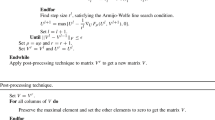Abstract
Partitioning a given data-set into subsets based on similarity among the data is called clustering. Clustering is a major task in data mining and machine learning having many applications such as text retrieval, pattern recognition, and web mining. Here, we briefly review some clustering related problems (k-means, normalized k-cut, orthogonal non-negative matrix factorization, ONMF, and isoperimetry) and describe their connections. We formulate the relaxed mean version of the isoperimetry problem as an optimization problem with non-negative orthogonal constraints. We first make use of a gradient-based optimization algorithm to solve this kind of a problem, and then apply a post-processing technique to extract a solution of the clustering problem. Also, we propose a simplified approach to improve upon solution of the 2-dimensional clustering problem, using the N-nearest neighbor graph. Inspired by this technique, we apply a multilevel method for clustering a given data-set to reduce the size of the problem by grouping a number of similar vertices. The number is determined based on two values, namely, the maximum and the average of the edge weights of the vertices connected to a selected vertex. In addition, using the connections between ONMF and k-means and between k-means and the isoperimetry problem, we propose an algorithm to solve the ONMF problem. A comparative performance analysis of our approach with other related methods shows outperformance of our approach, in terms of the obtained misclassification error rate and Rand index, on both benchmark and randomly generated problems as well as hard synthetic data-sets.








Similar content being viewed by others
References
Arthur D, Sergi V (2007) K-means++: the advantages of careful seeding. In: SODA ’07: proceedings of the eighteenth annual ACM-SIAM symposium on discrete algorithms, pp 1027–1035
Barzilai J, Borwein JM (1988) Two-point step size gradient methods. IMA J Numer Anal 8(1):141–148
Daneshgar A, Hajiabolhassan H, Javadi R (2010) On the isoperimetric spectrum of graphs and its approximations. J Comb Theory Ser B 100(4):390–412
Daneshgar A, Javadi R, Razavi SS (2013) Clustering and outlier detection using isoperimetric number of trees. Pattern Recogn 46(12):3371–3382
Ding C, He X, Simon HD (2005) On the equivalence of non-negative matrix factorization and spectral clustering. In: Proceedings of the SIAM international conference on data mining. Society for Industrial and Applied Mathematics, pp 606–610
Dhillon IS, Guan Y, Kulis B (2004) A unified view of kernel k-means, spectral clustering and graph cuts. Technical Report No. UTCS TR-04-25, Computer Science Department, University of Texas at Austin
Dolan ED, Moré JJ (2002) Benchmarking optimization software with performance profiles. Math Program 91(2):201–213
Jiang B, Dai YH (2015) A framework of constraint preserving update schemes for optimization on Stiefel manifold. Math Program 153(2):535–575
Kim J, Park H (2011) Fast non-negative matrix factorization: an active-set-like method and comparisons. SIAM J Sci Comput 33(6):3261–3281
Lancichinetti A, Fortunato S (2009) Benchmarks for testing community detection algorithms on directed and weighted graphs with overlapping communities. Phys Rev E 80(1):016118
Lawrence H, Phipps A (1985) Comparing partitions. J Classif 2(1):193–218
Li T, Ding C (2006) The relationships among various non-negative matrix factorization methods for clustering. In: Data mining. ICDM’06. Sixth international conference on IEEE, pp 362–371
Ng AY, Jordan MI, Weiss Y (2002) On spectral clustering: analysis and an algorithm. In: Scholkopf B, Platt J, Hoffman T (eds) Advances in neural information processing systems. MIT Press, Cambridge, pp 849–856
Nocedal J, Wright SJ (2006) Numerical optimization. Springer series in operations research and financial engineering, 2nd edn. Springer, New York
Peng J, Wei Y (2007) Approximating k-means-type clustering via semidefinite programming. SIAM J Optim 18(1):186–205
Pompili F, Gillis N, Absil PA, Glineur F (2014) Two algorithms for orthogonal non-negative matrix factorization with application to clustering. Neurocomputing 141:15–25
Wen Z, Yin W (2013) A feasible method for optimization with orthogonality constraints. Math Program 142(1–2):397–434
West DB (2001) Introduction to graph theory, vol 2. Prentice-Hall, Upper Saddle River
Acknowledgements
The authors thank the Research Council of Sharif University of Technology for supporting this work.
Author information
Authors and Affiliations
Corresponding author
Ethics declarations
Conflict of interest
Authors declare that they have no conflict of interest.
Additional information
Publisher's Note
Springer Nature remains neutral with regard to jurisdictional claims in published maps and institutional affiliations.
Rights and permissions
About this article
Cite this article
Dehghanpour-Sahron, J., Mahdavi-Amiri, N. A competitive optimization approach for data clustering and orthogonal non-negative matrix factorization. 4OR-Q J Oper Res 19, 473–499 (2021). https://doi.org/10.1007/s10288-020-00445-y
Received:
Revised:
Published:
Issue Date:
DOI: https://doi.org/10.1007/s10288-020-00445-y
Keywords
- Clustering
- Multilevel method
- Normalized k-cut
- Optimization problem
- Orthogonal non-negative matrix factorization




